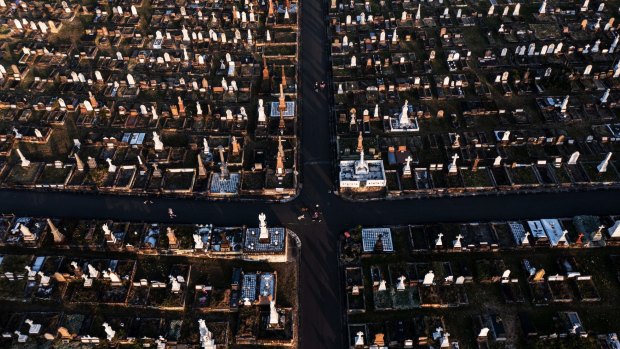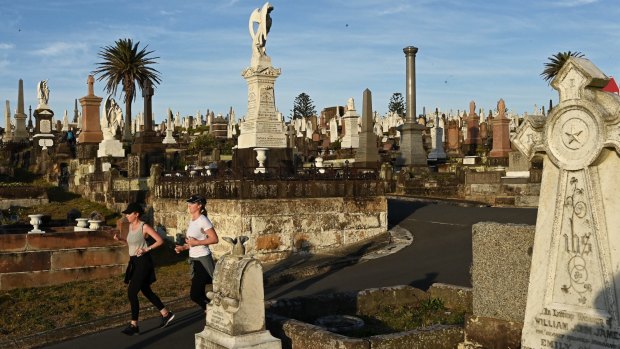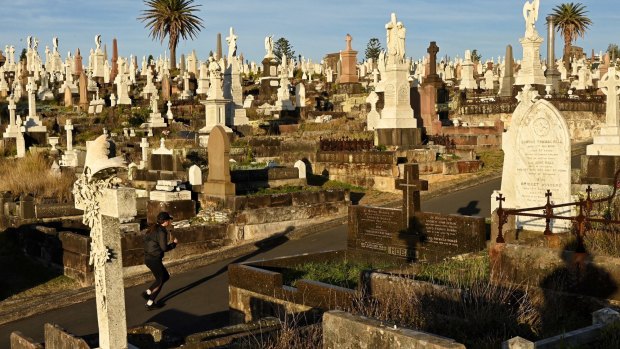This was published 2 years ago
Sydney cemeteries during lockdown: Escape the parks and discover history
By Jane Richards

Waverley Cemetery.Credit: Nick Moir
So the local streets have become mind-numbingly familiar, walking trails are too crowded for comfort and the dog park is well, feral. But if there's one place guaranteed to be mostly dead quiet in a pandemic it's an old cemetery.
Read about Melbourne's cemeteries here.
These often nature-filled pockets of peace offer locked-down citizens socially-distanced solitude - from Waverley with its clifftop angels and pounding surf, to St Stephen's in Newtown with its twisty Moreton Bay fig and graffitied walls.

Waverley cemetery is the resting place of Dorothea Mackellar and Henry Lawson.Credit: Nick Moir
Maddie Plant, a 26-year-old veterinary student from Clovelly, has taken to walking through Waverley cemetery, resting place of Dorothea Mackellar and Henry Lawson, to escape the crowds on the coast walk.
"I find it humbling ... it makes me reflect on things and reminds me to enjoy living," she says. "And since everyone has been working from home I have noticed people migrating to the cemetery."
Older cemeteries offer locked-down citizens socially-distanced solitude and something else just as treasured in these times - gripping stories.

A jogger runs through Waverley Cemetery.Credit: Nick Moir
In Manly Cemetery, where dogs and children are walking, there are tales of shipwreck, love-induced madness and snow-capped mountain feats amid the cherubs, cracked vases and mottled angels. Cemeteries, it becomes clear, are the stuff Netflix should be made of.
Take the tragic tale of Millicent Maude Bryant, born in 1878, the first woman in Australia to gain a pilot's licence. In 1927, not long after being left a widow with three sons, she drowned in Sydney Harbour with 39 others when her ferry, The Greycliffe, was cut in two by the steamer Tahiti. Shocked bystanders said the vessel sank in seconds on "the sunniest and calmest of days". Five planes flew over Millicent's funeral procession, dropping a flower wreath in tribute.
A few rows further on from her grave you'll spot an odd-shaped headstone, one that only canny Kiwis may pick as being reminiscent of their own Aoraki/Mount Cook. This carved stone was added to the unmarked grave of Sydney woman Freda Du Faur, in the early 2000s by some New Zealanders on a mission to discover her final resting place.
Du Faur, it turns out, was the first woman to climb Aoraki/Mount Cook and her mountaineering exploits in her "scandalous" outfit of a knee skirt with knickerbockers made her a household name across the ditch last century. Sadly, her exploits with an ice axe and ropes in 1910 were never celebrated in her home country, and despite her vowing to attempt the Himalayas, she abandoned her climbing career after a cruel forced separation from her long-time partner, Muriel Cadogan. She ended up alone and died by her own hand at her home in Dee Why in 1935. See what I mean about Netflix?
Old cemeteries are full of such stories, woven by the lives of their inhabitants. They offer an element of poetry not often stumbled across in everyday life and are also the few keepers of women's stories. And while many of these stories are sad, they also offer much needed perspective in these pandemic days. Imagine the resilience needed in the lives of people like "the first white couple in Manly", George and Martha Pickering. Martha died aged 90 in 1874 – about the time their resting place, Manly Cemetery, was built.
Enmore artist Cayenne Barnum grew up in Newtown and knows the charms of St Stephen's well.
"My mother is Mexican and death is a really normal and beautiful thing, the graveyard is a peaceful place," she says.
Mayor of Northern Beaches Council Michael Regan says: "There are reminders of difficult times in the past as you stroll through the grounds reading the inscriptions ... However, the cemetery is not a sad place, with uplifting sculptures of angels, obelisks and embellished religious crosses and a picturesque landscape of established trees."
Trees and gardens draw nature, too, to cemeteries. I've been hooted at by an owl in Newtown, startled by a snake in a western NSW cemetery and felt my own skin prickle when an echidna shuffled past mourners at a northern Sydney gravesite.
But no cemetery story is complete without one to leave you wondering.
Flashback to far too many years ago. I'm running through an old churchyard in western NSW on an icy, blue-sky day when I stop to catch my breath beside a grave surrounded by a spiked fence.
A scream. It's my friend. He's gasping, pointing.
"What?" I follow his gaze.
It's the name on the headstone. Yup, I'm standing next to my own grave.
With Billie Eder
See also: 'Visually stunning': Melbourne's cemeteries are a peaceful alternative to parks
Sign up for the Traveller Deals newsletter
Get exclusive travel deals delivered straight to your inbox. Sign up now.